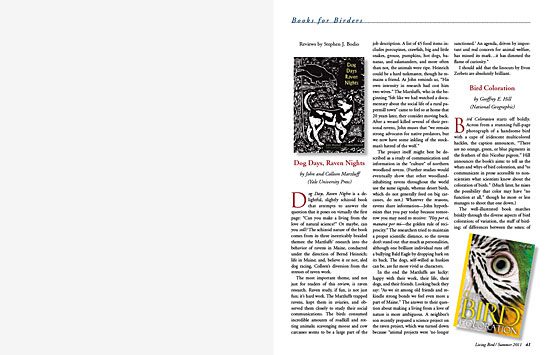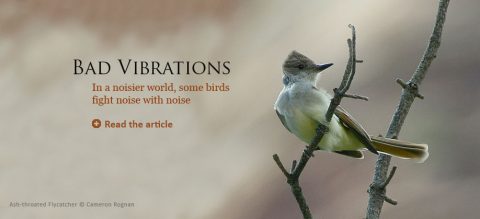Book Reviews: Dog Days, Raven Nights, by John and Colleen Marzluff
Reviewed by Stephen J. Bodio
July 15, 2011
Dog Days, Raven Nights is a delightful, slightly schizoid book that attempts to answer the question that it poses on virtually the first page: “Can you make a living from the love of natural science?” Or maybe, can you still? The schizoid nature of the book comes from its three inextricably braided themes: the Marzluffs’ research into the behavior of ravens in Maine, conducted under the direction of Bernd Heinrich; life in Maine; and, believe it or not, sled dog racing, Colleen’s diversion from the stresses of raven work.
The most important theme, and not just for readers of this review, is raven research. Raven study, if fun, is not just fun; it’s hard work. The Marzluffs trapped ravens, kept them in aviaries, and observed them closely to study their social communications. The birds consumed incredible amounts of roadkill and rotting animals; scavenging moose and cow carcasses seems to be a large part of the job description. A list of 45 food items includes porcupines, crawfish, big and little snakes, grouse, pumpkins, hot dogs, bananas, and salamanders, and more often than not, the animals were ripe. Heinrich could be a hard taskmaster, though he remains a friend. As John reminds us, “His own intensity in research had cost him two wives.” The Marzluffs, who in the beginning “felt like we had watched a documentary about the social life of a rural papermill town” came to feel so at home that 20 years later, they consider moving back. After a weasel killed several of their personal ravens, John muses that “we remain strong advocates for native predators, but we now have some inkling of the stockman’s hatred of the wolf.”
The project itself might best be described as a study of communication and information in the “culture” of northern woodland ravens. (Further studies would eventually show that other woodland-inhabiting ravens throughout the world use the same signals, whereas desert birds, which do not generally feed on big carcasses, do not.) Whatever the reasons, ravens share information—John hypothesizes that you pay today because tomorrow you may need to receive: “Hoy por ti, manana por mi—the golden rule of reciprocity.” The researchers tried to maintain a proper scientific distance, so the ravens don’t stand out that much as personalities, although one brilliant individual runs off a bullying Bald Eagle by dropping bark on its back. The dogs, self-willed as huskies can be, are far more vivid as characters.
In the end the Marzluffs are lucky: happy with their work, their life, their dogs, and their friends. Looking back they say: “As we sit among old friends and rekindle strong bonds we feel even more a part of Maine.” The answer to their question about making a living from a love of nature is more ambiguous. A neighbor’s son recently prepared a science project on the raven project, which was turned down because “animal projects were ‘no longer sanctioned.’ An agenda, driven by important and real concern for animal welfare, has missed its mark…it has dimmed the flame of curiosity.”
I should add that the linocuts by Evon Zerbets are absolutely brilliant.

All About Birds
is a free resource
Available for everyone,
funded by donors like you
American Kestrel by Blair Dudeck / Macaulay Library



